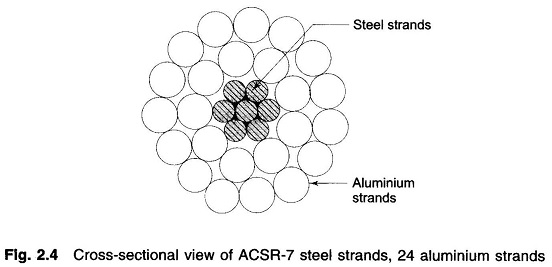ACSR Conductor (Aluminium Conductor Steel Reinforced):
ACSR Conductor – So far we have considered transmission lines consisting of single solid cylindrical conductors for forward and return paths. To provide the necessary flexibility for stringing, conductors used in practice are always stranded except for very small cross-sectional areas. Stranded conductors are composed of strands of wire, electrically in parallel, with alternate layers spiralled in opposite direction to prevent unwinding. The total number of strands (N) in concentrically stranded cables with total annular space filled with strands of uniform diameter (d) is given by
where x is the number of layers wherein the single central strand is counted as the first layer. The overall diameter (D) of a stranded conductor is
Aluminium is now the most commonly employed Conductor material. It has the advantages of being cheaper and lighter than copper though with less conductivity and tensile strength. Low density and low conductivity result in larger overall conductor diameter, which offers another incidental advantage in high voltage lines. Increased diameter results in reduced electrical stress at conductor surface for a given voltage so that the line is corona free.
The low tensile strength of aluminium conductors is made up by providing central strands of high tensile strength steel. Such a Conductor is known as Aluminium Conductor Steel Reinforced (ACSR) and is most commonly used in overhead transmission lines. Figure 2.4 shows the cross-sectional view of an ACSR conductor with 24 strands of aluminium and 7 strands of steel.
In extra high voltage (EHV) transmission line, expanded ACSR conductor are used. These are provided with paper or hessian between various layers of strands so as to increase the overall conductor diameter in an attempt to reduce electrical stress at conductor surface and prevent corona.
The most effective way of constructing corona-free EHV lines is to provide several conductors per phase in suitable geometrical configuration. These are known as bundled conductors and are a common practice now for EHV lines.
